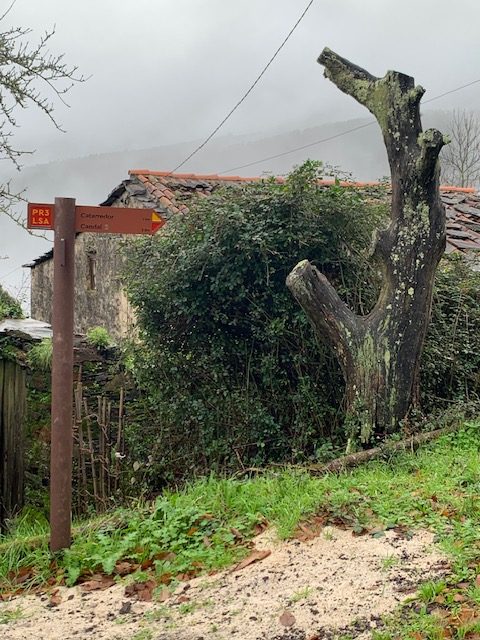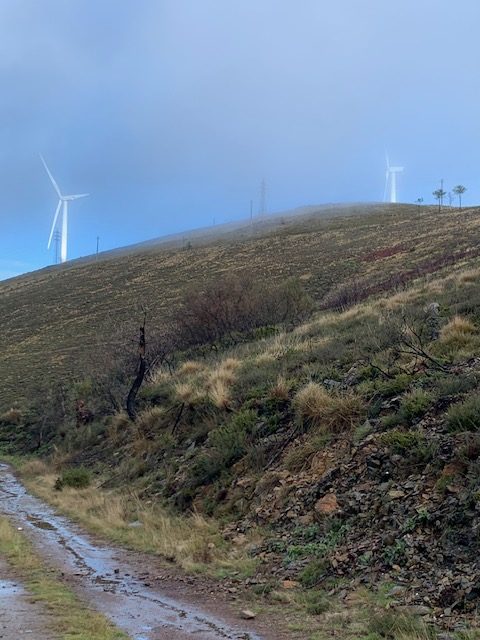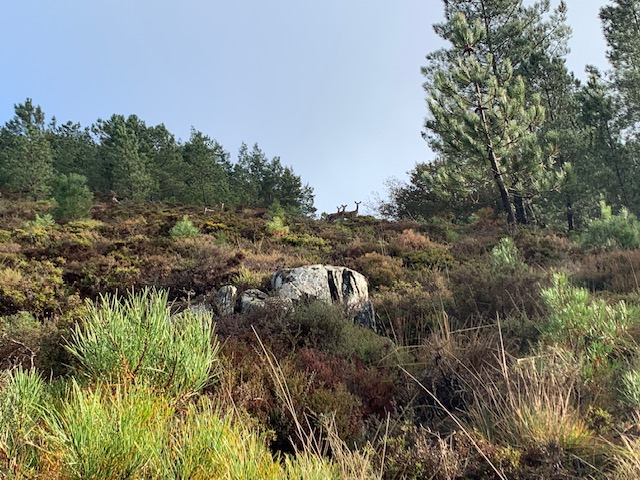It is late afternoon and day-trippers are arriving to view the sunset. Golden rays penetrate straight down the valley, bathing the village and the hill in warmth. The aldeias were well situated to capture as much daylight as possible. In the cool, dark valleys, the temperature change is palpable, especially near the many streams.
Despite the effort required to climb uphill, the uplands are the place to be. Once the sun sets, the air turns chilly and the cold and the darkness set in.
Abrigos, stone-built shelters for humans, animals and gear, dot the landscape. Most have fallen into ruin but others remain surprisingly sturdy, still resisting the clusters of climbing vines, roots, annual rains, moss, and even trees weaving through them. Not every village had its own school or a church; they were often
shared between groups of villages. Candal’s gleaming white primary school was built with funds remitted home by emigrés, who also built some of its larger houses when they returned.
On the terraced hills, locals farmed tiny, scattered patches for centuries, with the higher hills used as goat pastures where herds of hundreds grazed. The animals were tended on a rotating basis by village herdsmen, in proportion to the number of goats owned. The more livestock you owned, the more times you did your duty as herdsman. Chanfana, a hearty goat stew traditionally made with an older animal,
remains a popular and tasty dish.
Then, the forests which nowadays surround the villages did not exist. A government reforestation initiative in the early 1940s saw the terraces and pastures planted over with coniferous trees. It spelled the end of the schist villages, as the villagers’ livelihoods disappeared.
Wolves have long since been hunted to extinction from the forests, though there is talk of reintroducing them in some places. The result is plenty of deer, even on Cerdeira’s slate steps at night. In the fall, the clash of stags fighting and trumpeting for mates echoes over the hills. Wild boar, birds, butterflies and an incredible diversity of fungi dot the forests, which range from hardwoods like oak to pine plantations. Invasive eucalyptus and acacia have sprung up everywhere and are known fire-hazards due to their combustibility.
Hiking Hopscotch
It is impossible to curb the desire to follow the ancient trails connecting the villages, the rocks underfoot worn smooth from centuries of foot traffic. In previous centuries, the children of Cerdeira walked the 2.5 kms to Candal to school and back wending their way down into the valley and up again, hopscotching
across a stream and sidling along several chasms up to the undulating higher ground. Halfway through, the difficult trail becomes a logging road which descends cheerily downhill.
The area is justly popular with trail runners and mountain bikers who toil up and down the slopes. Some aldeias do xisto have “bike hotels” which offer storage and repair facilities.
I recommend Aldeias de Xisto Adventure Maps: Serras da Lousã & Açor Scale 1/30,000 for exploring the area by car or bike, but also on foot. Official trails are marked with two yellow and red slashes but not well maintained. Occasionally, other trails with conflicting symbols may pop into view. Hew to the main trail:
encountering offshoots (with no trail marking to indicate which direction to go), as well as downed trees, rickety bridges, and chains for handholds while crossing crevasses, is commonplace. In fall, with leaves littering the forest floor, trails may be difficult to pick out.
Rocks underfoot are often slippery, and become slick in the rain. Carry hiking poles, water, foot, a cell phone, compass and map. Plan to return well before dark. Wear sturdy shoes, a hat and carry a waterproof coat or poncho. If uncertain of the trail, continue only a few minutes or metres more, taking careful note (or even photos) of the trail. When in doubt, turn back. Becoming lost or injured is easy in the undulating, depopulated mountains.
In summer, there are many rocky pools, river beaches and cascades to cool off in, as well as the long flume of the aqueduct bring water into Talasnal. Often you can just jump into the water tank in one of the aldeias. It’s best to ask first. Bathing is encouraged at Cerdeira, though the water in the tanque never exceeds 16 degrees C., even on the hottest days.
Thanks again for this fabulous blog from Leslie Smith



Photo credit: Leslie Smith
1. Trail marker at Vaqueirinho
2. Above the treeline
3. Stag and does





